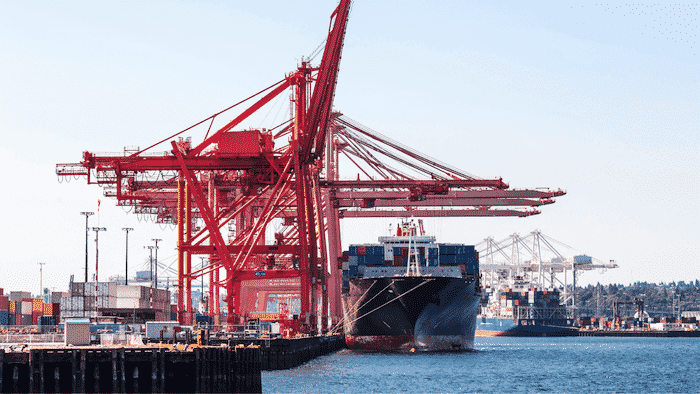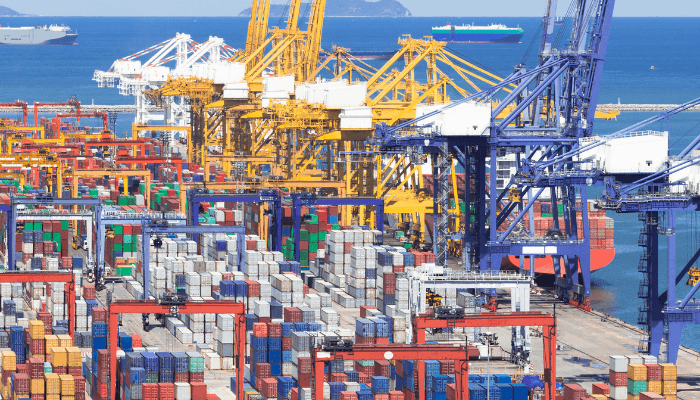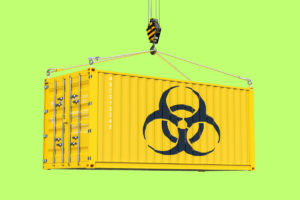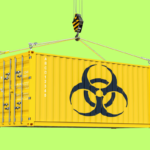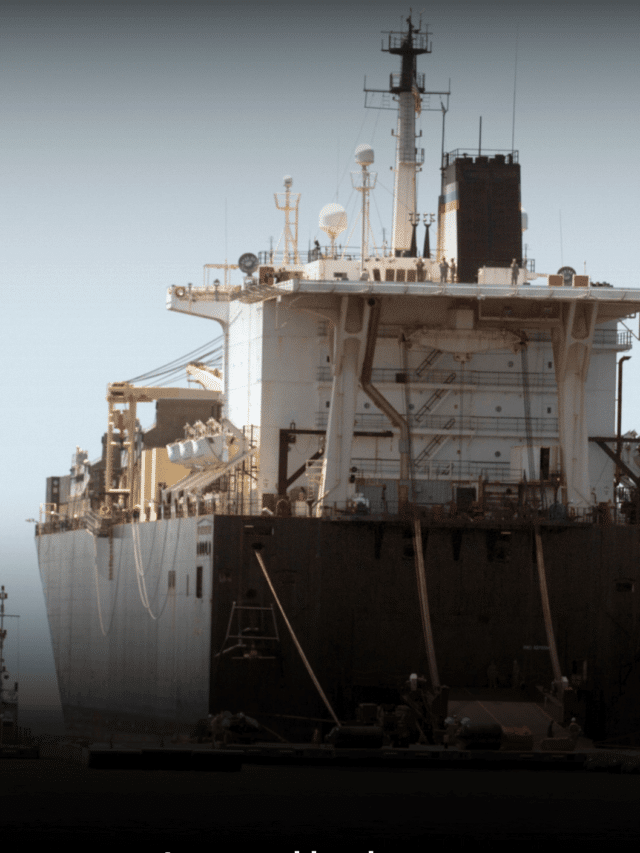What are Terminal Handling Charges?
Shipping terminals are facilities for the loading and unloading of goods and embarkation and disembarkation of passengers from ocean vessels.
A port can have separate terminals for handling the different activities.
A freight terminal is more specific to goods. The fees charged by a port terminal operator to the vessel operator are called Terminal Handling Charges or THC.
The Origin of Terminal Handling Charges
In the early days of trading and shipping goods by sea, a ship’s owner would pay the stevedores at the port for the loading and unloading of his cargo.
Stevedores are the port workers who are involved in the general operations at a port such as loading and unloading of cargo, operation of the port equipment such as cranes and derricks, assist in the berthing or unberthing of ships that come and go out of the port, etc.
With industrial development came more technological innovations. Ports developed separate terminals for handling the different types of cargo coming in and going out.
Each had different equipment that could handle this cargo more efficiently and safely. Gradually the jobs that were being carried out by hand were mechanized and ports started charging terminal handling charges to the shipping line.
What Does Terminal Handling Charges Include?
THC includes all the local charges of the terminal and hence varies from port to port. The THC charged by the Port of Shanghai, China will be different from that charged by the Port of Tanjong Pagar, Singapore.
Similarly, THC will be different between the ports of Hamburg, Germany or Rotterdam, Netherlands.
THC can be different between different terminals of the same port. This is because different terminals may have technologically different and advanced equipment for handling the various types of cargo.
The operations of a freight terminal, in specific, require a very large financial outlay. Employees of the terminal have to be paid their wages and salaries, infrastructure and equipment have to be serviced and maintained, taxes and surcharges have to be paid to the government, fees for the marketing of services – the list goes on.
Where do freight terminals get the money for all this spending?
Well, one such income is from the Terminal Handling Charges (THC). Apart from other charges, freight terminals charge THC on all the container cargo that comes in and goes out of it.
The terminal handling charges are sometimes referred to as the Container Service Charge or CSC.
The THC or the CSC are charged for the storage of containers within the terminal premises and their positioning before or after loading or unloading from an ocean carrier.
In detail, it includes the container handling charges, stacking, unloading or loading on a truck, for services of the crane or forklift, etc.
Understanding Terminal Handling Charges Through an Example
ABC Meats in Cape Town, South Africa is contracted to supply 3×20’ container loads of dressed lamb to DEF Imports of Doha, Qatar.
ABC Meats transports the 3×20’ reefer containers to the Port of Cape Town for shipment by container carrier St. Vincent.
Upon arrival at the port, the containers are lifted by the port cranes and stacked ready for dispatch. The reefer containers are monitored regularly by the port technicians to ensure that the gensets are working properly and the desired temperature is maintained until it is ready for loading onboard St. Vincent.
On ETD (Expected Time of Departure), these 3 containers are positioned for loading onboard the vessel. Once loading of all cargo is complete, the vessel sets sail as expected.
Here the costs incurred on the unloading of cargo from the trucks of ABC Meats, their storage at the Port premises, monitoring of the reefer containers, and subsequent loading onboard vessel St. Vincent by the Port Authority of the Port of Cape Town, are the terminal handling charges that are charged to the vessel operator.
Upon arrival at Port Doha, the 3 reefer containers are offloaded from the vessel and stacked for collection by DEF Imports. During storage, the reefers are monitored regularly for their efficient functioning by technicians of the port.
When the trucks of DEF Imports come for collection of the containers, they are loaded on these trucks by crane or a heavy-duty forklift.
The cost of these activities (unloading from the ship, stacking and storage, maintenance of reefer gensets during storage, and loading onto trucks) is recovered by way of terminal handling charges by the Doha Port authorities.
Types of Terminal Handling Charges
Terminal handling charges are charged by the terminal operator to the shipping company that moves the container. The shipping company passes on this charge to the seller or the customer who is sending or receiving the container cargo through the terminal.
THCs are payable at the port of origin, trans-shipment ports, as well as the port of discharge. Depending on the agreement between the seller and buyer, terminal handling charges at origin (OTHC) and terminal handling charges at the destination port (DTHC) will be paid either by the seller or the buyer.
They make this payment usually to the shipping company. Typically, any THC at a transhipment port is paid by the carrier as this is factored into their freight cost.
One point to note here is that equipment like refrigerated containers (reefers), Out-of-Gauge cargo (OOG), HAZMAT cargo (Hazardous Materials), etc. are charged different THCs.
This is because each of these types of cargo requires different handling equipment and the ways of handling them are also different.
Reefers need electrical connections to run their gensets. OOG cargo may require special handling equipment and more space for storage. Hazardous cargo may need to be sequestered and kept under temperature-controlled conditions.
Terminal handling charges are usually fixed by ports on an annual basis. Some shipping companies may also charge THC based on the volume of cargo.
Are Terminal Handling Charges and Wharfage Different?
Terminal handling charges normally include wharfage charge which is the charge for the use of a wharf or pier. Wharfage applies to containers as well as less-than-container loads (LCL) that are imported or exported through the terminal.
In the case of an LCL shipment where there is no THC, it is the wharfage charge that is shown on the invoice.
While THC is charged by container, wharfage charge is usually calculated by weight or volume. Also known as Revenue Ton (RT) it is calculated for weight or volume that is loaded or unloaded at the terminal in units of tons, cubic meters (CBM), etc.
Terminal Handling Charges and Cargo Traffic
As we have seen earlier in this article, terminal handling charges are different between terminals of different ports. It may also be different between terminals within the same port.
This can be one of the decisive factors for traders when it comes to choosing the port or terminal for export or import. Factors such as proximity to the market and convenience, facilities, and cost help traders decide their port of choice.
Proximity and Convenience
A shipping terminal should be easily accessible from the merchant’s location. Usually, port terminals are connected to industrial areas and business centres by good, well-serviced roads. This helps in the smooth movement of cargo from and to port terminals.
While good roads help in the transportation of cargo, a port terminal that is very far away from industrial and trading centres is not preferred by the trading community.
Perhaps the two main reasons for this could be the associated costs for overland haulage of goods meant for import or export and the time taken for the movement of these goods.
Facilities
Most modern port terminals are equipped with the latest technology for the berthing and unberthing of ocean vessels, their bunkering and maintenance, for the loading and unloading of the different types of cargo, etc. Better facilities mean more business.
Cost
Cost is another very important factor in doing business. Traders weigh in on the different options available to them and go for the best. Unusually high charges such as terminal handling charges can drive away customers to other nearby ports that may charge a lesser rate. It may also make them consider other modes of transport such as road or rail that may work out cheaper without compromising on the quality.
You might also like to read:
- What is Merchant Haulage?
- Guide to Cold Chain Logistics – Things You Must Know
- What is Demurrage and Detention in Shipping?
- NOTIFY PARTY in Shipping: Everything You Wanted To Know
- What Is Consignee And Consignor In Shipping?
Disclaimer: The authors’ views expressed in this article do not necessarily reflect the views of Marine Insight. Data and charts, if used, in the article have been sourced from available information and have not been authenticated by any statutory authority. The author and Marine Insight do not claim it to be accurate nor accept any responsibility for the same. The views constitute only the opinions and do not constitute any guidelines or recommendation on any course of action to be followed by the reader.
The article or images cannot be reproduced, copied, shared or used in any form without the permission of the author and Marine Insight.
Do you have info to share with us ? Suggest a correction

About Author
Hari Menon is a Freelance writer with close to 20 years of professional experience in Logistics, Warehousing, Supply chain, and Contracts administration. An avid fitness freak, and bibliophile, he loves travelling too.
Latest Maritime law Articles You Would Like:
Latest News
- What are Logistics Risks?
- How Port and Terminal Operators Can Control Emissions?
- Minimum Quantity Commitment (MQC) and Liquidated Damages in Container Shipping: Concept and Relevance
- MARPOL (The International Convention for Prevention of Marine Pollution For Ships): The Ultimate Guide
- The Ultimate Shipping Container Dimensions Guide
- A Comprehensive Overview of IMDG Code for Shipping Dangerous Goods
Subscribe To Our Newsletters
By subscribing, you agree to our Privacy Policy and may receive occasional deal communications; you can unsubscribe anytime.
Web Stories



